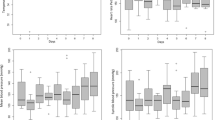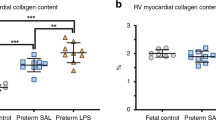Abstract
Our aim was to characterize an ovine model of preterm birth that allows analysis of the developmental effects of preterm birth in the absence of postnatal confounding factors. Preterm birth was induced at 131 days of gestation in 82 lambs; controls (n = 31) were born at term (145 days). Overall survival of preterm lambs was 60%; males had significantly lower survival than females (44% vs 76%); 94% of term lambs survived. Although the birth weight of preterm lambs was ∼0.9 kg lower than in term lambs, the crown-to-rump and forelimb lengths were similar. At 9 weeks after term-equivalent age, there were no differences in body weight or dimensions between preterm and term lambs; when adjusted for body weight, the heart was 21% heavier in preterm than term lambs. We conclude that moderately preterm birth in sheep is characterized by a greater survival of female lambs than males and has significant effects on organ development.
Similar content being viewed by others
References
Tracy SK, Tracy MB, Dean J, Laws P, Sullivan E. Spontaneous preterm birth of liveborn infants in women at low risk in Australia over 10 years: a population-based study. BJOG. 2007;114(6):731–735.
Hamilton BE, Martin JA, Ventura SJ. Births: preliminary data for 2007. Natl Vital Stat Rep. 2009;57(12):1–23.
Bonamy AK, Bendito A, Martin H, Andolf E, Sedin G, Norman M. Preterm birth contributes to increased vascular resistance and higher blood pressure in adolescent girls. Pediatr Res. 2005;58(5):845–849.
Dalziel SR, Parag V, Rodgers A, Harding JE. Cardiovascular risk factors at age 30 following pre-term birth. Int J Epidemiol. 2007;36(4):907–915.
Irving RJ, Belton NR, Elton RA, Walker BR. Adult cardiovascular risk factors in premature babies. Lancet. 2000;355(9221):2135–2136.
Doyle LW. Cardiopulmonary outcomes of extreme prematurity. Semin Perinatol. 2008;32(1):28–34.
Nuyt AM, Alexander BT. Developmental programming and hypertension. Curr Opin Nephrol Hypertens. 2009;18(2):144–152.
Baraldi E, Filippone M. Chronic lung disease after premature birth. N Engl J Med. 2007;357(19):1946–1955.
Christou H, Brodsky D. Lung injury and bronchopulmonary dysplasia in newborn infants. J Intensive Care Med. 2005;20(2):76–87.
Greenough A. Long-term pulmonary outcome in the preterm infant. Neonatology. 2008;93(4):324–327.
Jobe AH, Bancalari E. Bronchopulmonary dysplasia. Am J Respir Crit Care Med. 2001;163(7):1723–1729.
Doyle LW, Anderson PJ. Long-term outcomes of bronchopulmonary dysplasia. Semin Fetal Neonatal Med. 2009;14(6):391–395.
Ferriero DM. Neonatal brain injury. N Engl J Med. 2004;351(19):1985–1995.
Stephens BE, Vohr BR. Neurodevelopmental outcome of the premature infant. Pediatr Clin North Am. 2009;56(3):631–646.
Goldenberg RL, Culhane JF, Iams JD, Romero R. Epidemiology and causes of preterm birth. Lancet. 2008;371(9606):75–84.
Saigal S, Doyle LW. An overview of mortality and sequelae of preterm birth from infancy to adulthood. Lancet. 2008;371(9608):261–269.
Petrini JR, Dias T, McCormick MC, Massolo ML, Green NS, Escobar GJ. Increased risk of adverse neurological development for late preterm infants. J Pediatr. 2009;154(2):169–176.
Clark RH. The epidemiology of respiratory failure in neonates born at an estimated gestational age of 34 weeks or more. J Perinatol. 2005;25(4):251–257.
Benjamin DK Jr, Stoll BJ. Infection in late preterm infants. Clin Perinatol. 2006;33(4):871–882.
Adamkin DH. Feeding problems in the late preterm infant. Clin Perinatol. Dec 2006;33(4):831–837.
Darcy AE. Complications of the late preterm infant. J Perinat Neonatal Nurs. 2009;23(1):78–86.
Engle WA, Tomashek KM, Wallman C. “Late-preterm” infants: a population at risk. Pediatrics. 2007;120(6):1390–1401.
Cock M, Hanna M, Sozo F, et al. Pulmonary function and structure following mild preterm birth in lambs. Pediatr Pulmonol. 2005;40(4):336–348.
De Matteo R, Snibson K, Thompson B, Koumoundouros E, Harding R. Lung function in developing lambs: is it affected by preterm birth? J Appl Physiol. 2009;107(4):1083–1088.
De Matteo R, Stacy V, Probyn M, Desai M, Ross M, Harding R. The perinatal development of arterial pressure in sheep: effects of low birth weight due to twinning. Reprod Sci. 2008;15(1):66–74.
De Matteo R, Stacy V, Probyn ME, Brew N, Blasch N, Harding R. Does moderate preterm birth lead to altered arterial pressure? Studies in sheep. Clin Exp Pharmacol Physiol. 2008;35(12):1426–1432.
Maritz G, Probyn M, De Matteo R, Snibson K, Harding R. Lung parenchyma at maturity is influenced by postnatal growth but not by moderate preterm birth in sheep. Neonatology. 2008;93(1):28–35.
Snibson K, Harding R. Postnatal growth rate, but not mild preterm birth, influences airway structure in adult sheep challenged with house dust mite. Exp Lung Res. 2008;34(2):69–84.
Snibson KJ, Bischof RJ, Koumoundouros E, McMurtrie LS, Cock M, Harding R. Altered airway responsiveness in adult sheep born prematurely: effects of allergen exposure. Exp Lung Res. 2006;32(6):215–228.
Sozo F, Wallace MJ, Hanna MR, et al. Alveolar epithelial cell differentiation and surfactant protein expression after mild preterm birth in sheep. Pediatr Res. 2006;59(1):151–156.
Walker AM, de Preu ND. Preterm birth in lambs: sleep patterns and cardio-respiratory changes. J Dev Physiol. 1991;16(3):139–145.
Silver M. Effects on maternal and fetal steroid concentrations of induction of parturition in the sheep by inhibition of 3 beta-hydroxysteroid dehydrogenase. J Reprod Fertil. 1988;82(2):457–465.
Elsmen E, Hansen Pupp I, Hellstrom-Westas L. Preterm male infants need more initial respiratory and circulatory support than female infants. Acta Paediatr. 2004;93(4):529–533.
Pollak A, Birnbacher R. Preterm male infants need more initial respiratory support than female infants. Acta Paediatr. 2004;93(4):447–448.
Thomas MR, Marston L, Rafferty GF, et al. Respiratory function of very prematurely born infants at follow up: influence of sex. Arch Dis Child Fetal Neonatal Ed. 2006;91(3):F197–F201.
Mitchell BF, Taggart MJ. Are animal models relevant to key aspects of human parturition? Am J Physiol Regul Integr Comp Physiol. 2009;297(3):R525–R545.
Alexander GR, Kogan M, Bader D, Carlo W, Allen M, Mor J. US birth weight/gestational age-specific neonatal mortality: 1995–1997 rates for whites, hispanics, and blacks. Pediatrics. 2003;111(1):e61–e66.
Pulver LS, Guest-Warnick G, Stoddard GJ, Byington CL, Young PC. Weight for gestational age affects the mortality of late preterm infants. Pediatrics. 2009;123(6):e1072–e1077.
Ballard PL, Ballard RA, Granberg JP, et al. Fetal sex and prenatal betamethasone therapy. J Pediatr. 1980;97(3):451–454.
Papageorgiou AN, Colle E, Farri-Kostopoulos E, Gelfand MM. Incidence of respiratory distress syndrome following antenatal betamethasone: role of sex, type of delivery, and prolonged rupture of membranes. Pediatrics. 1981;67(5):614–617.
Willet KE, Jobe AH, Ikegami M, et al. Postnatal lung function after prenatal steroid treatment in sheep: effect of gender. Pediatr Res. 1997;42(6):885–892.
Provost PR, Boucher E, Tremblay Y. Apolipoprotein A-I, A-II, C-II, and H expression in the developing lung and sex difference in surfactant lipids. J Endocrinol. 2009;200(3):321–330.
Fleisher B, Kulovich MV, Hallman M, Gluck L. Lung profile: sex differences in normal pregnancy. Obstet Gynecol. 1985;66(3):327–330.
Nielsen HC, Zinman HM, Torday JS. Dihydrotestosterone inhibits fetal rabbit pulmonary surfactant production. J Clin Invest. 1982;69(3):611–616.
Kovar J, Waddell BJ, Sly PD, Willet KE. Sex differences in response to steroids in preterm sheep lungs are not explained by glucocorticoid receptor number or binding affinity. Pediatr Pulmonol. 2001;32(1):8–13.
Wallace MJ, Zahra VA, Crossley K, Wintour EM, Cole TJ, Hooper SB. Regulation of glucocorticoid receptor mRNA in fetal lung. Paper presented at: Ninth Perinatal Society of Australia and New Zealand; April 20, 2005; Adelaide, Australia.
Sozo F, Ishak N, De Matteo R, Hooper S, Harding R. Structural and biochemical development of the ovine fetal lung: are there gender differences? J Paediatr Child Health. 2009;45(s1):A114.
Landmann E, Reiss I, Misselwitz B, Gortner L. Ponderal index for discrimination between symmetric and asymmetric growth restriction: percentiles for neonates from 30 weeks to 43 weeks of gestation. J Matern Fetal Neonatal Med. 2006;19(3):157–160.
Olsen IE, Lawson ML, Meinzen-Derr J, et al. Use of a body proportionality index for growth assessment of preterm infants. J Pediatr. 2009;154(4):486–491.
Hay WW Jr. Strategies for feeding the preterm infant. Neonatology. 2008;94(4):245–254.
Louey S, Cock ML, Stevenson KM, Harding R. Placental insufficiency and fetal growth restriction lead to postnatal hypotension and altered postnatal growth in sheep. Pediatr Res. 2000;48(6):808–814.
Bensley JG, Stacy VK, De Matteo R, Harding R, Black MJ. Cardiac remodelling as a result of pre-term birth: implications for future cardiovascular disease. European Heart Journal. In press. doi:10.1093/eurheartj/ehq104.
Author information
Authors and Affiliations
Corresponding author
Rights and permissions
About this article
Cite this article
De Matteo, R., Blasch, N., Stokes, V. et al. Induced Preterm Birth in Sheep: A Suitable Model for Studying the Developmental Effects of Moderately Preterm Birth. Reprod. Sci. 17, 724–733 (2010). https://doi.org/10.1177/1933719110369182
Published:
Issue Date:
DOI: https://doi.org/10.1177/1933719110369182




